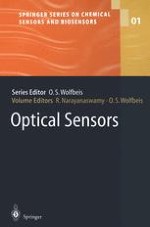Optical sensor technology has reached a level of technological maturity that makes it a promising candidate for applications to specific sensing challenges including those in environmental monitoring, in process control (particularly in biotechnology), in clinical assays where low-cost one-way sensing elements are needed, and in other areas. Optical sensors can be used as fiber optic microsensors, as planar coatings in bioreactors, in microtiterplate format, in disposable single-shot devices, and as planar membranes that can be imaged using sensitive cameras. The spectral range extends from the UV to the infrared, and from absorption to emission and to surface plasmon resonance. Hence, a variety of schemes are conceivable, and this first volume of the Springer Series on Chemical Sensors and Biosensors gives a state-of-the-art description of this highly sophisticated but very promising technology.
